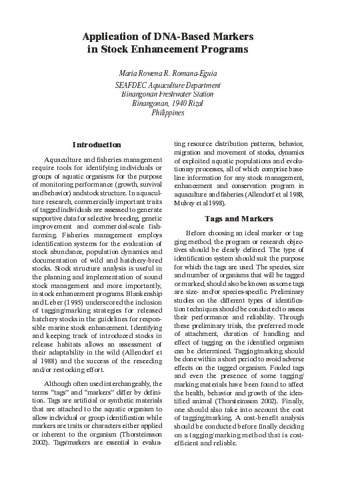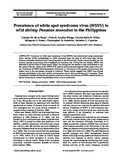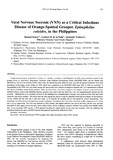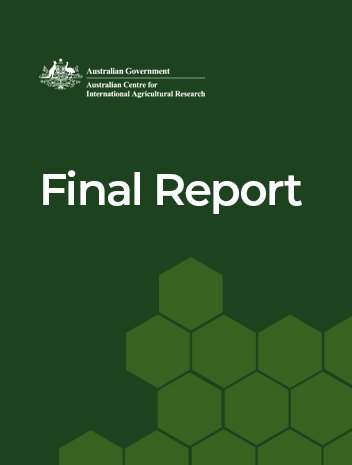Application of DNA-based markers in stock enhancement programs
Share
Abstract
Aquaculture and fisheries management require tools for identifying individuals or groups of aquatic organisms for the purpose of monitoring performance (growth, survival and behavior) and stock structure. In aquaculture research, commercially important traits of tagged individuals are assessed to generate supportive data for selective breeding, genetic improvement and commercial-scale fish farming. Fisheries management employs identification systems for the evaluation of stock abundance, population dynamics and documentation of wild and hatchery-bred stocks. Stock structure analysis is useful in the planning and implementation of sound stock management and more importantly, in stock enhancement programs. Blankenship and Leber (1995) underscored the inclusion of tagging/marking strategies for released hatchery stocks in the guidelines for responsible marine stock enhancement. Identifying and keeping track of introduced stocks in release habitats allows an assessment of their adaptability in the wild (Allendorf et al., 1988) and the success of the reseeding and/or restocking effort. Although often used interchangeably, the terms ‘tags’ and ‘markers’ differ by definition. Tags are artificial or synthetic materials that are attached to the aquatic organism to allow individual or group identification while markers are traits or characters either applied or inherent to the organism (Thorsteinsson, 2002). Tags/markers are essential in evaluating resource distribution patterns, behavior, migration and movement of stocks, dynamics of exploited aquatic populations and evolutionary processes, all of which comprise baseline information for any stock management, enhancement and conservation program in aquaculture and fisheries (Allendorf et al 1988, Mulvey et al., 1998).
Suggested Citation
Romana-Eguia, M. R. R. (2006). Application of DNA-based markers in stock enhancement programs. In J. H. Primavera, E. T. Quinitio, & M. R. R. Eguia (Eds.), Proceedings of the Regional Technical Consultation on Stock Enhancement for Threatened Species of International Concern, Iloilo City, Philippines, 13-15 July 2005 (pp. 7-15). Tigbauan, Iloilo, Philippines: Aquaculture Department, Southeast Asian Fisheries Development Center.
Subject
Related items
Showing items related by title, author, creator and subject.
-
Prevalence of white spot syndrome virus (WSSV) in wild shrimp Penaeus monodon in the Philippines
de la Peña, Leobert D.; Lavilla-Pitogo, Celia R.; Villar, Corina Belle R.; Paner, Milagros G.; Sombito, Christopher D.; Capulos, Geimbo C. (Inter Research, 2007)Prevalence of white spot syndrome virus (WSSV) was determined using polymerase chain reaction (PCR) methodology on DNA extracted from the gills of wild black tiger shrimp Penaeus monodon collected from 7 sampling sites in ... -
Viral nervous necrosis (VNN) as a critical infectious disease of orange-spotted grouper, Epinephelus coioides, in the Philippines
Kiryu, Ikunari; de la Peña, Leobert D.; Yoshiura, Yasutoshi; Ototake, Mitsuru; Maeno, Yukio (Japan International Research Center for Agricultural Sciences, 2007)Orange-spotted grouper, Epinephelus coioides, is a valuable commodity in the Philippines. In 2001, mass mortality occurred in the grouper larvae at Aquaculture Department, Southeast Asian Fisheries Development Center ... -
Developing technologies for giant grouper (Epinephelus lanceolatus) aquaculture in Vietnam, the Philippines and Australia
Nocillado, Josephine; Elizur, Abigail; Palma, Peter; Dennis, Lachlan; Ninh, Nguyen Huu; de Jesus-Ayson, Evelyn Grace T.; In, Vu Van; Thai, Truong Quoc; Anderson, Kelli; Luu, Thi Ha Giang; Knibb, Wayne; Knuckey, Richard; Canépa, Maximiliano; Bright, David (Australian Centre for International Agricultural Research, 2021-06-29)This project established a sustainable aquaculture industry for giant grouper in Vietnam and the Philippines through the development of captive breeding and larval-rearing techniques. Captive breeding innovations and ...





